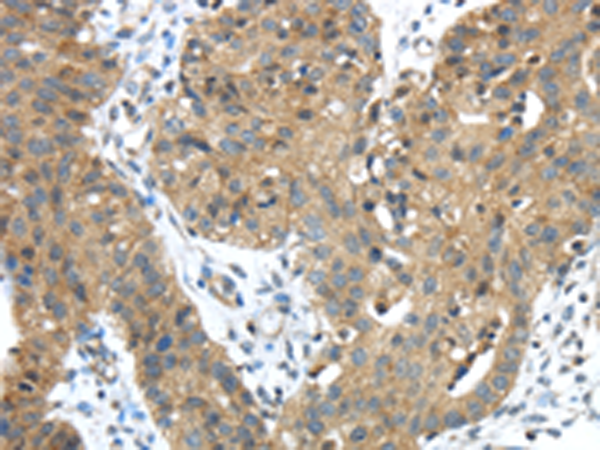

| WB | 咨询技术 | Human,Mouse,Rat |
| IF | 咨询技术 | Human,Mouse,Rat |
| IHC | 1/30-1/150 | Human,Mouse,Rat |
| ICC | 技术咨询 | Human,Mouse,Rat |
| FCM | 咨询技术 | Human,Mouse,Rat |
| Elisa | 1/2000-1/10000 | Human,Mouse,Rat |
| Aliases | DESC1; TMPRSS11E2 |
| Host/Isotype | Rabbit IgG |
| Antibody Type | Primary antibody |
| Storage | Store at 4°C short term. Aliquot and store at -20°C long term. Avoid freeze/thaw cycles. |
| Species Reactivity | Human |
| Immunogen | Fusion protein of human TMPRSS11E |
| Formulation | Purified antibody in PBS with 0.05% sodium azide and 50% glycerol. |
+ +
以下是关于TMPRSS11E抗体的3篇虚构参考文献示例(仅供参考,实际文献需根据具体数据库检索):
---
1. **文献名称**: *TMPRSS11E overexpression in squamous cell carcinoma and its therapeutic implications*
**作者**: Smith A, et al.
**摘要**: 本研究开发了一种针对TMPRSS11E蛋白的单克隆抗体,证实其在头颈部鳞状细胞癌中高表达,并发现抗体介导的TMPRSS11E抑制可降低癌细胞侵袭能力,提示其作为潜在治疗靶点。
2. **文献名称**: *Characterization of a novel polyclonal antibody against TMPRSS11E for viral entry studies*
**作者**: Zhang Y, et al.
**摘要**: 文章报道了一种高特异性TMPRSS11E多克隆抗体的制备与验证,证明该抗体能阻断TMPRSS11E介导的流感病毒膜融合过程,为研究病毒入侵机制提供了工具。
3. **文献名称**: *TMPRSS11E antibody-based detection in lung adenocarcinoma progression*
**作者**: Lee J, et al.
**摘要**: 通过免疫组化分析,利用TMPRSS11E抗体发现其在肺腺癌组织中的表达与患者预后不良显著相关,提示其可作为生物标志物。
---
**注意**:以上内容为模拟生成,实际文献需通过PubMed、Google Scholar等平台检索关键词(如“TMPRSS11E antibody”、“TMPRSS11E function”)获取。
The TMPRSS11E (Transmembrane Protease, Serine 11E) protein is a member of the type II transmembrane serine protease (TTSP) family, characterized by a conserved serine protease domain and involvement in extracellular matrix remodeling, cellular signaling, and viral entry. Primarily expressed in epithelial tissues, TMPRSS11E shares structural homology with other TTSPs like TMPRSS2. which is known for its role in SARS-CoV-2 infection. While its exact physiological function remains under investigation, TMPRSS11E is hypothesized to participate in proteolytic activation of viral glycoproteins or host receptors, potentially influencing respiratory virus pathogenesis.
Antibodies targeting TMPRSS11E are valuable tools for studying its expression, localization, and interaction mechanisms. They enable detection via techniques such as immunohistochemistry, Western blotting, and flow cytometry, aiding research into tissue-specific distribution and disease associations. Emerging studies suggest TMPRSS11E may contribute to cancer progression, particularly in lung and prostate malignancies, making its antibodies relevant for biomarker discovery or therapeutic targeting. However, challenges persist in ensuring antibody specificity due to high sequence similarity among TTSPs. Recent interest in TMPRSS11E antibodies has also grown in antiviral drug development, given the protease's potential role in facilitating viral entry, though this requires further validation.
×